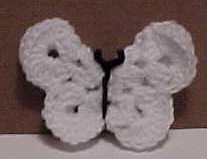Chain
6, sl st in 6th ch from hk to form a ring. All subsequent stitches
are made in right side of work.
RND
1 [petal round]: Ch 3 (counts as first dc). Work the following
stitches inside the ring you just made, 2 dc, ch 1 [first petal
made], * 3 dc, ch 1. Repeat from * 6 times more [ending with ch 1]
for a total of 8 petals. Join with sl st in top 1st dc. DO NOT TURN.
RND
2 [cluster round]: Sl st in next dc, sc in ch-1 sp, ch 3. (2dc, ch
1, 3 dc, ch 1) in same ch 1 sp [first cluster made]. * (3 dc, ch 1, 3
dc, ch 1) in each remaining ch 1 sp [ending with ch 1] for a total of
8 clusters. Join with sc in top of beg ch 3. DO NOT CH OR TURN.
RND
3 [shell round]: 9 dc first ch1 sp [center of cluster from previous
round]. * Sc in next open space, 9 dc in next ch 1 sp. Repeat from *
around, for a total of 8 shells. Join with sc in top of beg sc. DO
NOT CH OR TURN.
RND
4: sc in each stitch [ edges will/should curl in toward center of
work].
FASTEN
OFF.
WEAVE IN ALL YARN ENDS.
TO
FINISH: Fold work in half lining up the sets of 9 dcs. Fasten a pipe
cleaner around the centre and twist to form antennae. (see photos for
placement)
I
use a g-hook with worsted weight yarn, a d- or e-hook for sport or
baby weight, and a b-hook for sock weight yarn.
I
have found that some people crochet looser with an f-hook than I do
with a g-hook, so adjust to suit yourself. Body/antennae can be
formed using ½ of a standard [12-inch] chenille wire, or a standard
6- to 8-inch pipe cleaner. If you crochet very loosely, you might
want to use 7 inches of chenille wire. I use the end of a small hook
to curl the wire ends [either in or out] so as not to leave an
exposed point.

